Convert PDF Bank Statement to CSV
Convert PDF bank statement to CSV for accurate financial records. Save time, reduce errors, and simplify expense tracking with organized transaction data.
Add Your File
Drag & Drop Or Select File
Data security is our top priority
Bank Statement Converters prioritises the confidentiality and integrity of your data. As a testament to our commitment, we adhere to stringent compliance standards, including GDPR, SOC 2, and HIPAA. Privacy Policy



How to Convert PDF Bank Statement To CSV Effectively
Why Choose Convert PDF Bank Statement to CSV?
Accessibility
You can access our service anytime, anywhere without complications. It converts your PDF bank statements to CSV files, keeping transactions organized.
Affordable Plans for Everyone
Affordable Plans for Everyone tailored to meet diverse needs without breaking the bank, offering flexibility and value for all.
Starter
$90 / month
Save 10% annually
Why should you take this
4,800 pages per year
PDF Bank Statement to Excel
PDF Bank Statement to CSV
Convert Password Protected Statement
Multiple PDFs to a Single CSV
Global Banks Supported
Get Started
Professional
$180 / month
Save 20% annually
Why should you take this
12,000 pages per year
PDF Bank Statement to Excel
PDF Bank Statement to CSV
Convert Password Protected Statement
Multiple PDFs to a Single CSV
Global Banks Supported
Get Started
Business
$360 / month
Save 20% annually
Why should you take this
48,000 pages per year
PDF Bank Statement to Excel
PDF Bank Statement to CSV
Convert Password Protected Statement
Multiple PDFs to a Single CSV
Global Banks Supported
Get Started
Most Popular
Enterprise
$Custom / month
Save 20% annually
Why should you take this
PDF Bank Statement to Excel
PDF Bank Statement to CSV
Convert Password-Protected Statement
Multiple PDFs to a Single CSV
Global Banks Supported
Get Started
Why PDF Bank Statement to CSV Converter Outperforms Excel Templates?
Features
PDF Bank Statement to CSV Converter
Excel Templates
Auto Extraction from PDF
Built in Bank Format Recognition
No Manual Data Entry
Batch File Processing
Error Free Column Alignment
Faster Report Generation
Handles Complex Statement Layouts
Consistent Output for Accounting Software
Requires No Formulas or Macros
Cleaner Data Structure for Filtering/Sorting
Frequently Asked Questions
What file formats do bank statement converters support?
Can I convert scanned bank statements?
Is there a file size limit when converting bank statements?
Keeping track of your financial transactions shouldn’t be a hassle, but dealing with PDF bank statements can make it complicated. One efficient way to simplify this task is to convert PDF bank statement to CSV for easy handling and analysis.
A bank statement converter helps by quickly turning your PDFs into organized CSV files, making data analysis and management much easier.
With this tool, you can save time, reduce errors, and gain better insights into your financial records. In this article, you’ll learn how a bank statement converter works, its key benefits, and how it simplifies financial management.
By the end, you'll be able to handle your financial data more efficiently and with greater accuracy.
What Does a PDF Bank Statement to CSV Converter Do?
A PDF bank statement to CSV converter is a tool that turns non-editable PDF bank statements into structured CSV files. It extracts transaction data like dates, descriptions, and amounts, helping you organize financial records easily.
This converter eliminates manual entry, saving time and reducing errors. You can analyze, categorize, and manage your transactions without dealing with complex PDFs.
It simplifies bookkeeping, prepares data for tax reports, and supports accounting software integration. Whether for personal or business use, it ensures accuracy and gives you full control over your financial data.
How Does Converting PDF Bank Statements to CSV Help You?
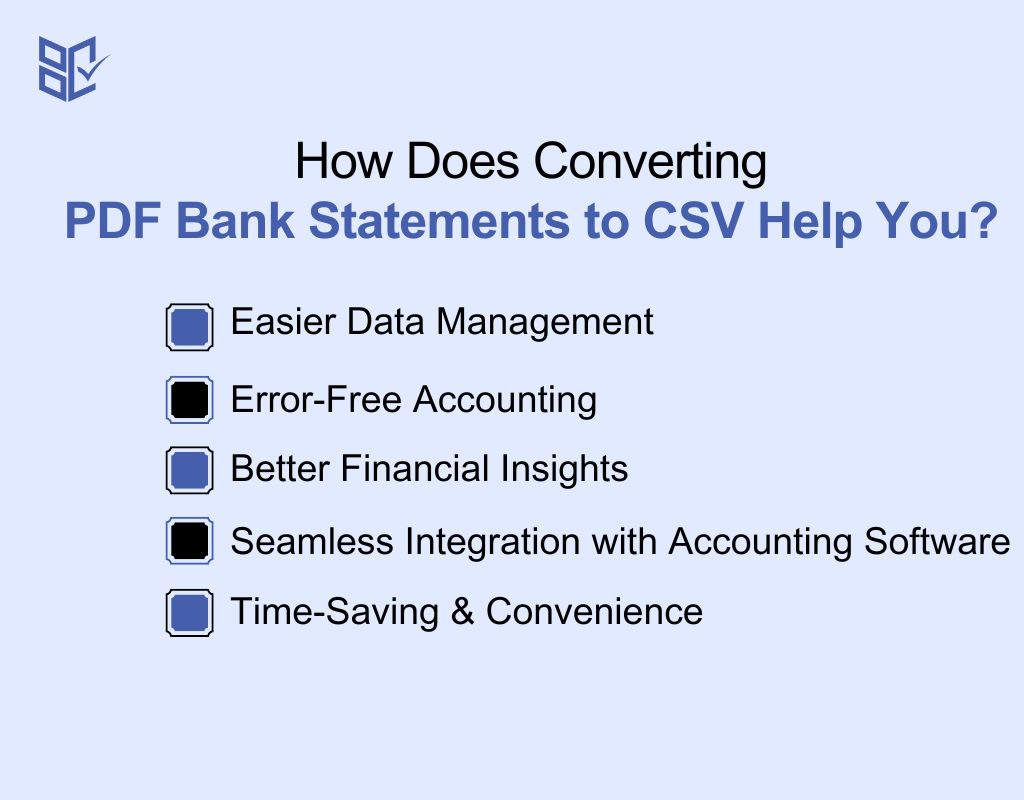
Handling financial data from PDF bank statements can be frustrating, especially when you need to organize or analyze transactions. Converting them into CSV makes financial tracking easier, faster, and more accurate. Here’s why it’s essential:
Easier Data Management
PDF bank statements are hard to work with when organizing finances. By converting them into CSV, you can sort, filter, and analyze your transactions more efficiently. This helps you categorize expenses, track income, and prepare financial reports without manually entering data, saving time and reducing frustration.
Error-Free Accounting
Manually entering transactions from PDFs to Excel spreadsheets or accounting software can lead to mistakes. A bank statement converter automates this process, ensuring accuracy. It extracts transaction details without human errors, making bookkeeping more reliable.
Better Financial Insights
Analyzing finances is difficult when data is locked in PDFs. Converting statements into structured formats lets you create reports, identify spending patterns, and monitor cash flow. With clear, organized data, you can make informed financial decisions, set budgets, and track savings or business growth more effectively.
Seamless Integration with Accounting Software
Most accounting tools like QuickBooks or Xero require transactions in CSV or Excel format. A bank statement converter helps you upload financial data effortlessly, eliminating the need for manual data entry.
Time-Saving & Convenience
Going through PDFs, copying transactions, and pasting them into spreadsheets takes a lot of time. A bank statement converter automates this process in seconds, giving you instant access to well-organized data.
Whether for personal finance, business accounting, or digital bank statement preparation, it simplifies financial management and increases efficiency
How to Easily Convert a PDF Bank Statement to CSV
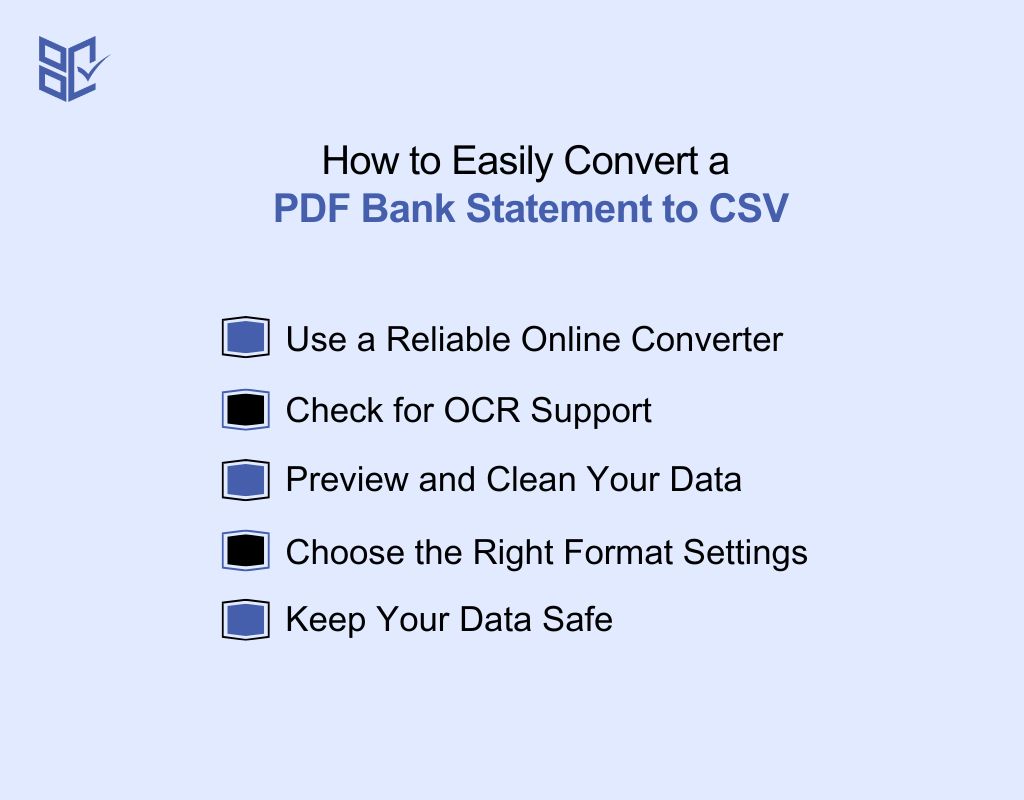
PDF bank statements are hard to edit or analyze. Converting them to CSV gives you a clean, editable format for sorting, calculating, and uploading to your finance tools. Here’s how you can do it step by step:
Use a Reliable Online Converter
If you want a quick solution without software, online converters are the best place to start. Choose a tool made for bank statements. Upload your PDF, and the tool will extract your transaction data into CSV format. Make sure it supports your layout and uses OCR if the PDF is scanned or image-based.
Check for OCR Support
Go for a converter that includes OCR (Optical Character Recognition). This feature reads text from scanned images. It helps pull accurate transaction details and saves you from manual typing or fixing unreadable data later.
Preview and Clean Your Data
After downloading the CSV, check for missing or misaligned values. Make sure dates, amounts, and descriptions are correct. Fix any issues before using the data in reports, budgets, or accounting software. A clean file avoids future errors.
Choose the Right Format Settings
Some tools let you choose format settings. Always adjust them before downloading. Select comma-separated values (CSV), choose your date format, and match column headers if needed. These settings make sure your file works with Excel, Google Sheets, or any accounting tool you plan to use.
Keep Your Data Safe
You’re dealing with sensitive bank info. Make sure the tool you use doesn’t store or misuse your data. Use trusted converters with strong privacy policies. Look for end-to-end encryption and no data storage guarantees. Avoid uploading files to unknown websites, especially if they don’t clearly explain how your data is handled.
Who Uses CSV Versions of PDF Bank Statements?
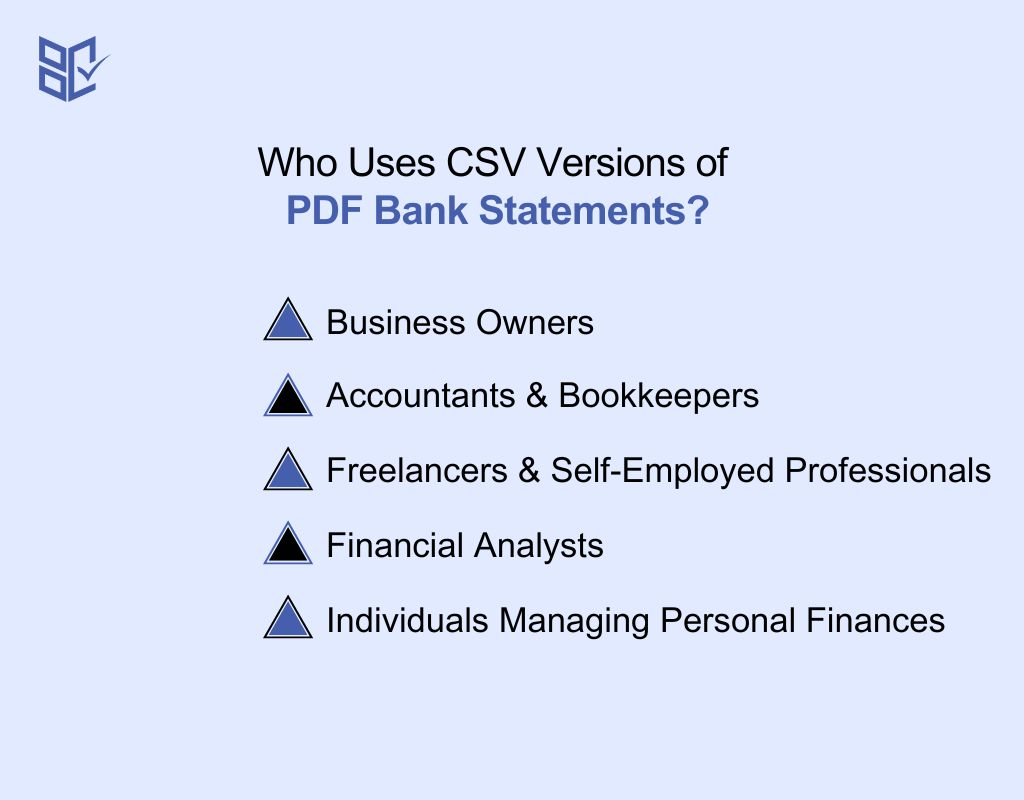
If you deal with financial data, a bank statement converter can make your work easier. Whether for personal use or business needs, converting bank statements saves time and improves accuracy. Here’s who benefits the most:
Business Owners
Running a business means handling many transactions daily. A PDF to CSV converter helps manage cash flow, track expenses, and generate reports. It reduces manual work and improves record accuracy. The CSV files also integrate smoothly with accounting tools, simplifying your entire financial process.
Accountants & Bookkeepers
Managing client finances requires accuracy and speed. A PDF to CSV converter saves time by automatically extracting transaction data. It eliminates manual entry errors, making it easier to prepare tax files, perform reconciliations, and handle audits. The result is faster, cleaner, and more reliable financial reporting.
Freelancers & Self-Employed Professionals
Freelancers and solo professionals must track income and expenses for tax and budgeting. A converter turns PDF statements into clear spreadsheets, helping organize finances. This automation improves accuracy, saves time, and ensures you're always ready for tax season or financial planning.
Financial Analysts
Analysts need structured data to assess trends and create reports. Converting PDF bank statements to CSV makes it easy to study cash flow and spending patterns. It supports better insights, speeds up reporting, and helps provide accurate, data-driven advice to clients, teams, or decision-makers.
Individuals Managing Personal Finances
Tracking personal income and spending is easier with CSV files. A converter transforms PDF statements into editable spreadsheets, helping you plan budgets, monitor expenses, and stay on top of your savings. It puts your financial data in a usable format for smarter money management.
What Should You Consider Before Using a PDF to CSV Converter?
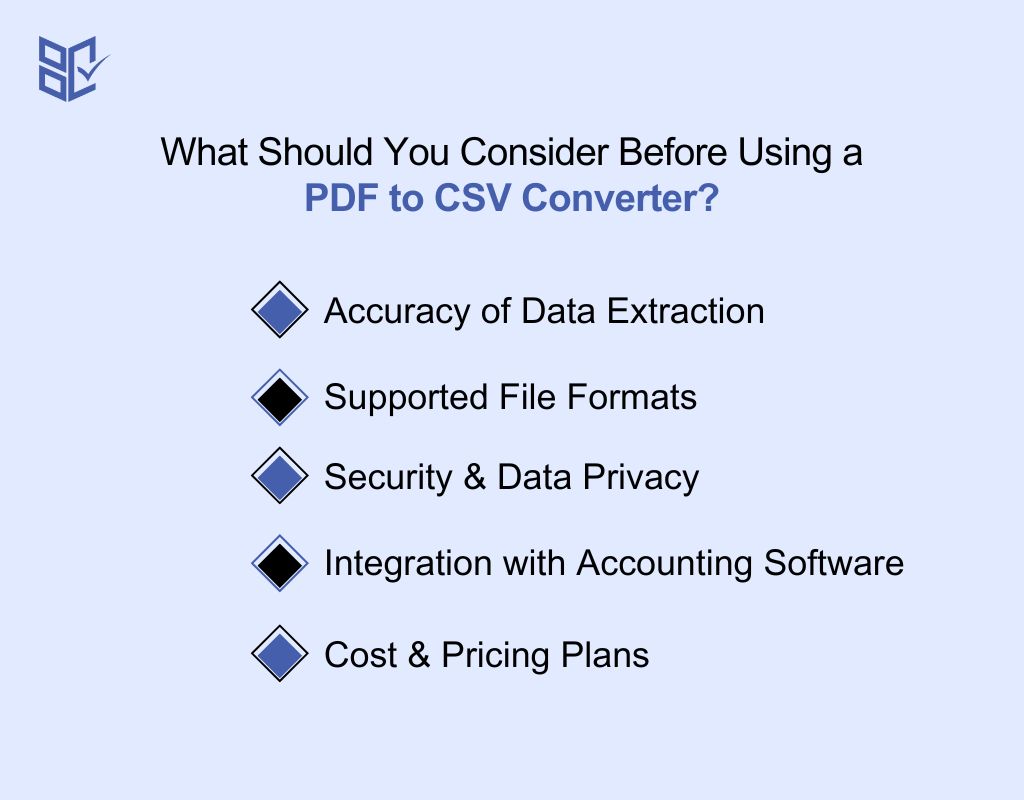
Choosing the right PDF bank statement to CSV converter ensures accuracy, security, and ease of use. With many options available, it's important to select the best one for your needs. Here’s what to consider:
Accuracy of Data Extraction
A good PDF to CSV converter should extract transactions correctly, including dates, descriptions, and amounts. Look for a tool with high accuracy and minimal errors. AI-powered or OCR-based converters work best for complex statements, ensuring that your financial data remains clean, structured, and ready for further analysis.
Supported File Formats
Ensure the converter supports the file format you need, whether it's Excel (XLS), CSV, JSON, or QuickBooks-compatible formats. If you plan to integrate the data into accounting software, choosing a converter with multiple format options will make the process easier.
Security & Data Privacy
Since bank statements contain sensitive financial data, security should be a top priority. Choose a bank statement converter that uses encryption and does not store or share your data. If using an online tool, check for secure connections (SSL encryption) and ensure it complies with data protection standards.
Integration with Accounting Software
If you use accounting tools like QuickBooks, Xero, or FreshBooks, choose a bank statement converter that offers seamless integration. Some converters allow direct uploads to these platforms, making bookkeeping effortless. This helps automate financial management and keeps your records accurate without extra manual work.
Cost & Pricing Plans
Many bank statement converters offer free, subscription-based, or one-time purchase options. If you need frequent conversions, a paid tool with advanced features may be worth the investment. For occasional use, free or pay-per-conversion tools can be a more cost-effective solution. Always check for hidden fees.
Challenges and Limitations When Converting PDF to CSV

Managing financial records can be tricky, and finding the right bank statement converter is no different. You need a tool that’s accurate, secure, and easy to use. However, there are several challenges and limitations that you should be aware of before making a decision.
Accuracy Issues
A PDF bank statement to CSV converter must correctly extract data without errors. If it misreads numbers, transactions, or formats, your financial records can be incorrect. Errors in conversion can lead to miscalculations, affecting budgeting, accounting, and tax filing. Always test a converter’s accuracy before relying on it.
Security Risks
Your bank statements contain sensitive financial data. If a converter lacks strong security features, your personal and business information could be at risk. Look for tools with encryption and strict privacy policies to ensure that your data is safe from hackers or unauthorized access.
Compatibility Problems
Not all converters support every file format. Some may struggle with PDFs, scanned documents, or non-standard bank statements. If the tool can’t handle your specific file type, you’ll waste time looking for alternatives or manually fixing errors, which defeats the purpose of automation.
Cost vs. Quality Balance
Free converters may seem attractive, but they often come with limitations such as watermarks, restricted features, or hidden fees. On the other hand, premium converters can be costly. You need to find a tool that offers the right balance between affordability and functionality.
Limited Customization Options
Every business or individual has unique financial needs. A rigid converter that doesn’t allow adjustments to categories, formats, or data structures may not fit your workflow. Look for a tool that offers customization options to better suit your financial tracking requirements.
Slow Processing Speed
Some converters take too long to process files, especially if you have large statements with many transactions. Slow tools can delay your work and reduce efficiency. A good converter should be able to handle high volumes of data quickly without compromising accuracy.
Recommended PDF Bank Statement to CSV Conversion Tools
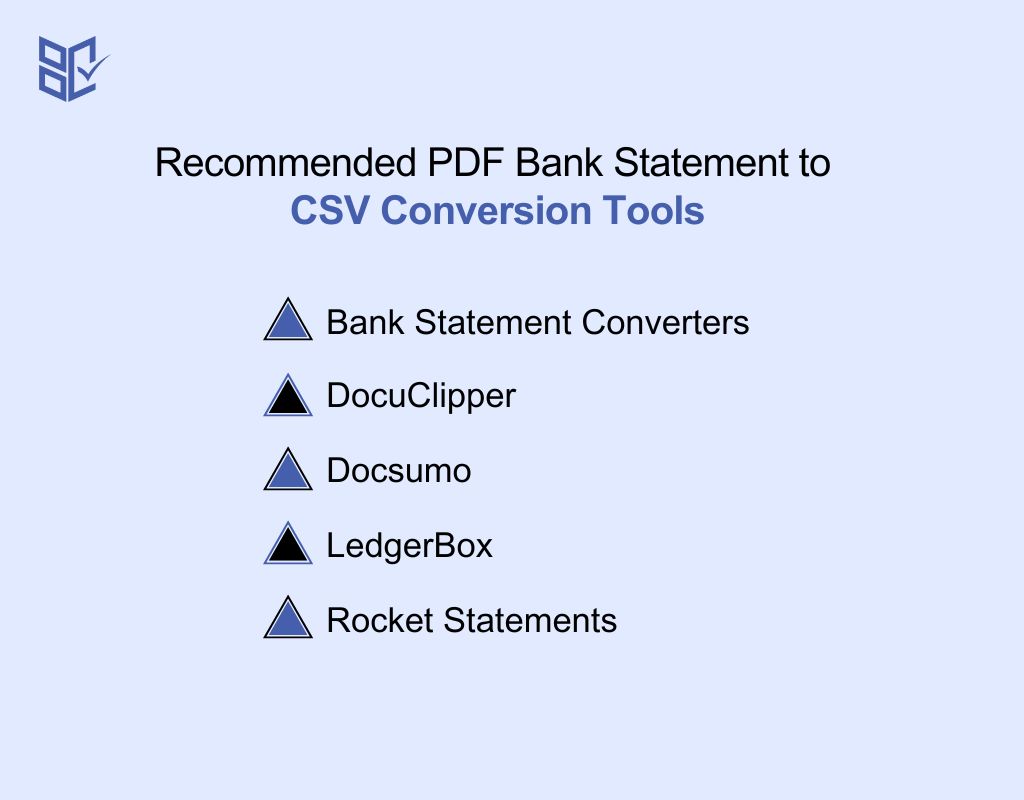
Managing your financial data efficiently often requires converting bank statements into editable formats. To assist you, here are top 5 PDF bank statement to CSV converter tools:
Bank Statement Converters
If you need a quick and simple way to convert bank statements into Excel, Bank Statement Converters is a great choice. It supports thousands of banks worldwide and ensures secure data processing. You don’t need to sign up—just upload your file, convert it, and download the results instantly with minimal effort.
DocuClipper
DocuClipper is a fast and accurate bank statement converter designed for businesses and accountants. It extracts data from PDF and converts it into CSV, and accounting software formats. With advanced OCR technology, it ensures 99% accuracy, making financial record-keeping and reconciliation simple and hassle-free.
Docsumo
Docsumo is an AI-powered bank statement converter that helps you extract, analyze, and verify financial data with ease. It processes complex statements with high accuracy and allows customization to fit your needs.
Whether for personal finance or business accounting, Docsumo ensures that your financial data is clean, organized, and reliable.
LedgerBox
LedgerBox is designed for accountants and bookkeepers who need accurate and secure bank statement conversion. It extracts financial data and integrates smoothly with accounting software like QuickBooks and Xero. With its AI-driven automation, it helps you process large amounts of financial data efficiently.
Rocket Statements
Rocket Statements is a powerful tool for converting bank statements into Excel, CSV, and other formats. It supports bulk processing and offers a clean, structured output for easy financial analysis. With AI-driven accuracy and security encryption, it’s perfect for businesses, accountants, and individuals.
Free vs. Paid PDF to CSV Bank Statement Converters
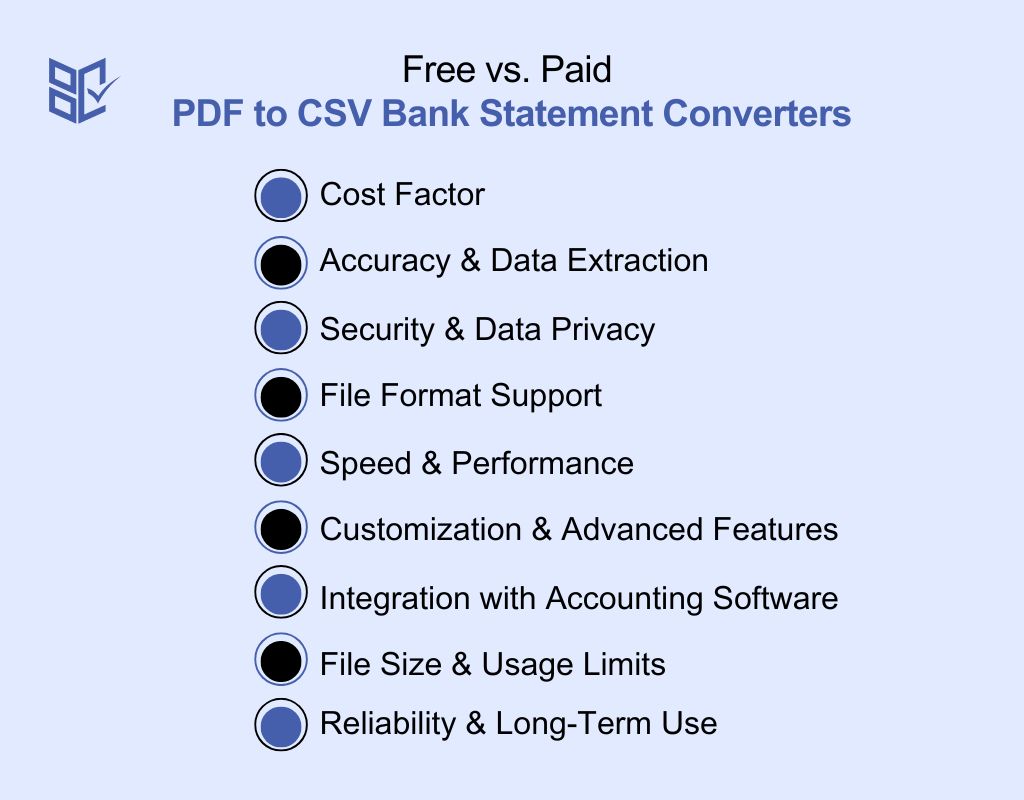
Choosing between a free or paid bank statement converter depends on your needs, budget, and how often you need to convert statements. Both options have their advantages and limitations. Let’s break down the key differences to help you decide.
Cost Factor
Free Converters: No upfront cost, making them ideal for occasional users or those on a tight budget.
Paid Converters: Require a one-time fee or subscription, but offer better features, security, and support.
Accuracy & Data Extraction
Free Converters: Basic OCR or text recognition, which may result in formatting errors or missing data.
Paid Converters: Advanced AI-powered OCR ensures 99% accuracy, reducing manual corrections and errors.
Security & Data Privacy
Free Converters: May store or use your data for other purposes; some lack encryption, posing a security risk.
Paid Converters: Offer bank-level encryption, ensuring your financial data remains private and protected.
File Format Support
Free Converters: Limited to basic formats like CSV or Excel, and may not support bank-specific statements.
Paid Converters: Support multiple formats (CSV, Excel, OFX, QBO, QuickBooks, etc.) for seamless accounting integration.
Speed & Performance
Free Converters: Can be slow, especially with large files; may have usage limits (e.g., one file per day).
Paid Converters: Faster processing speeds and bulk conversion options for high-volume users.
Customization & Advanced Features
Free Converters: Offer basic conversion without the ability to modify or categorize transactions.
Paid Converters: Allow you to customize column names, categories, and transaction types for better organization.
Integration with Accounting Software
Free Converters: Typically lack direct integration with tools like QuickBooks, Xero, or Sage.
Paid Converters: Seamlessly sync with accounting software, reducing manual data entry and saving time.
File Size & Usage Limits
Free Converters: Often restrict file size, number of conversions per day, or add watermarks to results.
Paid Converters: No file size limits; some offer unlimited conversions depending on the subscription plan.
Reliability & Long-Term Use
Free Converters: Suitable for one-time or occasional use but may be unreliable for frequent conversions.
Paid Converters: More stable and efficient for regular users, businesses, and accountants who need high accuracy.
Conclusion
Converting your PDF bank statements to CSV is a smart way to manage your finances better. It saves you time, reduces errors, and helps you avoid manual data entry. With CSV files, you can easily track expenses, prepare tax reports, and organize transactions.
Moreover, it allows smooth integration with accounting software for faster bookkeeping. As a result, you gain more control over your financial data. So, convert PDF bank statement to CSV to keep your records accurate, clear, and ready for analysis.